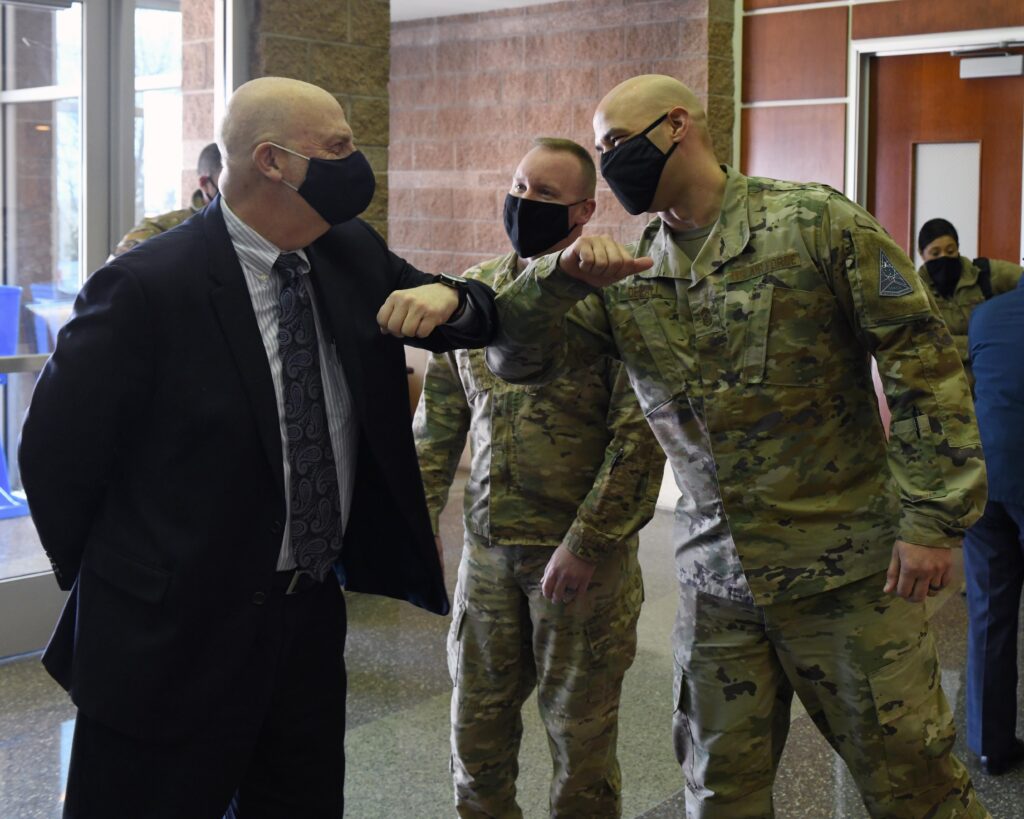
Acting Air Force Secretary John Roth, left
WASHINGTON: Key House lawmakers today pushed the Air Force to move faster, and farther, to reform space acquisition — with both HAC-D Chair Rep. Betty McCollum and Ranking Member Rep. Ken Calvert expressing concern about the slow pace.
In particular, lawmakers expressed impatience at the lack of movement toward creation of a new space acquisition czar independent of the Air Force’s assistant secretary for acquisition and integration (a post formerly held by Will Roper; now in an acting role by Darlene Costello).
“I am very concerned about the lack of progress with fixing these long-standing problems with space acquisition,” said McCollum. She stressed the importance of the new assistant secretary as the person with the authority to “make decisions on the budget and to align the resources with those acquisitions.” Breaking D readers remember that the biggest reason Congress began pressing for a Space Corps or Space Force was to improve space acquisition.
Acting Air Force Secretary John Roth, in a response that signals a shift from the previous administration, agreed that changes need to be made more swiftly in how the service’s civilian leadership oversee space programs.
“I share your concern,” Roth told the House Appropriations defense subcommittee hearing today on the Air Force and Space Force budget priorities for 2022. “That position needs to be filled as soon as possible.”
The 2020 NDAA required that the Air Force appoint a Senate-confirmed assistant secretary for space acquisition and integration. That person, the act said, “will “synchronize with the Air Force Service Acquisition Executive on all space system efforts, and take on Service Acquisition Executive responsibilities for space systems and programs effective on October 1, 2022.”
That October timeframe for the transfer of budget authority from the office of the Air Force assistant secretary for acquisition and integration to a new independent space office reflects a deal Congress cut with DoD, at the insistence of former Air Force acquisition czar Will Roper. Roper reportedly threatened to resign if the separation happened any sooner.
To that end, Roth suggested that the Air Force could propose legislation to allow the new space acquisition assistant secretary to take on Service Acquisition Executive (SAE) authorities as soon as he or she is appointed — which he said he assumes will happen “shortly.”
That suggestion to revise the 2020 NDAA to do just that is something that lawmakers have been considering as a spur to deeper reforms.
Roth further noted that the Air Force hasn’t been “sitting on its hands” on the issue of space acquisition, noting the reorganization of its civilian bureaucracy to support the new assistant secretary — as well as changes being put in place by Space Force chief Gen. Jay Raymond to streamline command structures via the transformation of Space and Missile Systems Center to a new Space Systems Command.
In the Air Force’s so-called Posture Statement for Fiscal Year 2022, the service told the HAC-D that the Space Force’s plans to create a Program Integration Council (PIC) to support the new civilian acquisition czar in pushing cross-service collaboration and avoiding duplication in space programs.
Today’s hearing was supposed to review the Air Force and Space Force 2022 budget. But there isn’t one yet from the Biden Administration, begging the question of what lawmakers were able to accomplish.
Incredibly for longtime Hill watchers, the service’s so-called posture statement did not include a single dollar figure.
That left lawmakers to fall back on long-standing, and for the most part parochial, beefs with the Air Force. A number of lawmakers, for example, warned against Air Force efforts to divest legacy aircraft (which are, of course, housed in their respective districts) to invest in transformative new technologies.
“I’m not the only member on this subcommittee that really is deeply concerned with Air Force plans to … decrease the number of our tactical airlift workhorses in the inventory, the C-130s of our National Guard,” said Rep. Cheri Bustos. Her Illinois district is home to the Air National Guard’s 182 Airlift Wing.
In the face of the all-too predictable congressional resistance to change, Roth and Air Force Chief of Staff Gen. CQ Brown were adamant in their defense of the service’s plans to pivot funds to developing next-generation capabilities aimed at besting Russia and China in any future fight.
Brown, for example, reiterated that the goal of the ongoing study of Air Force combat aircraft is looking across the fleet portfolio to define “what is the best mission capability as we as we go to the future” to meet the growing threat.
In a ‘world first,’ DARPA project demonstrates AI dogfighting in real jet
“The potential for machine learning in aviation, whether military or civil, is enormous,” said Air Force Col. James Valpiani. “And these fundamental questions of how do we do it, how do we do it safely, how do we train them, are the questions that we are trying to get after.”


























